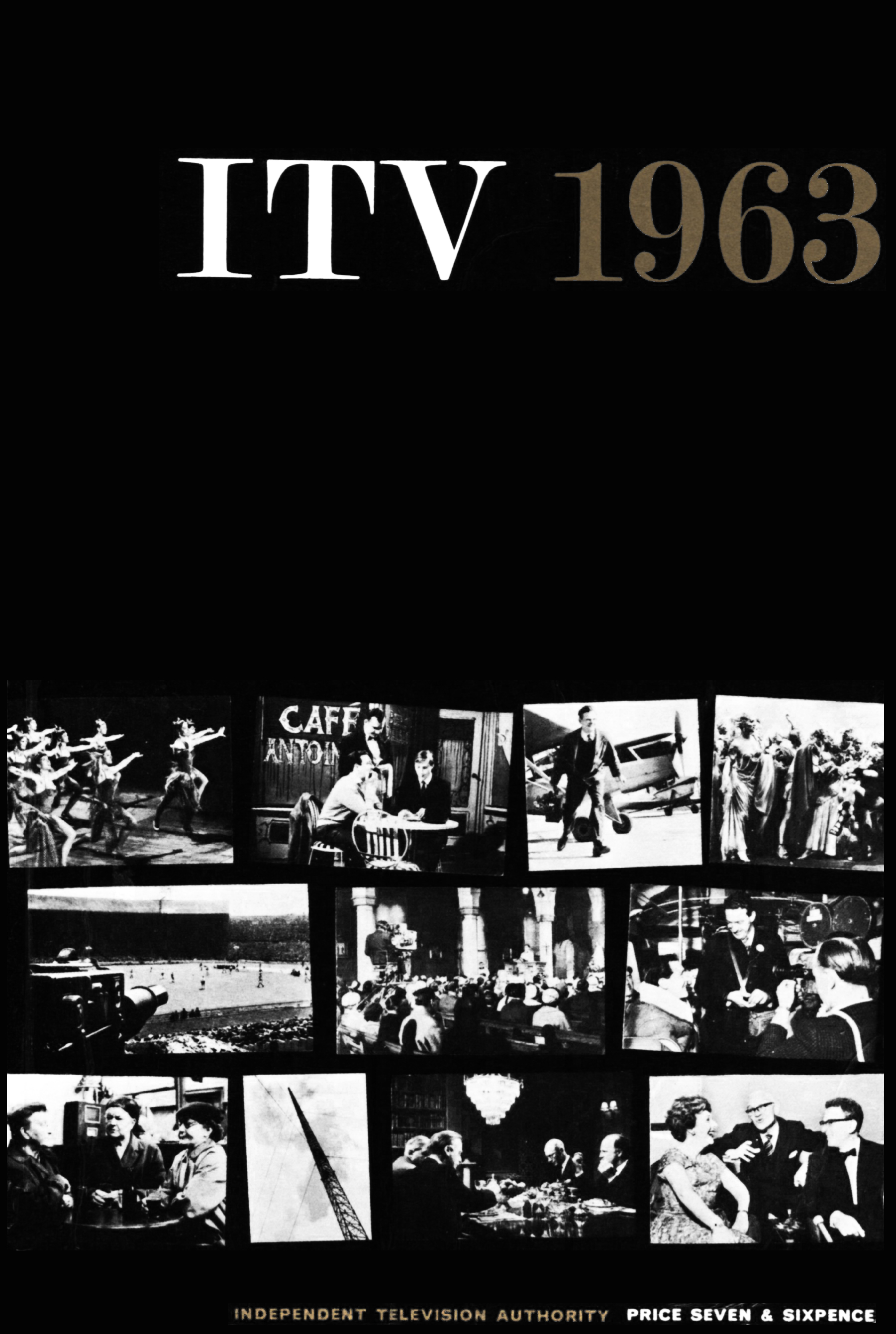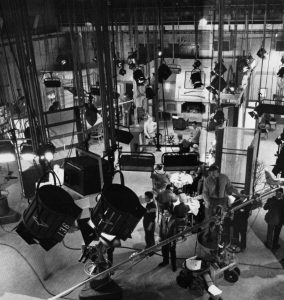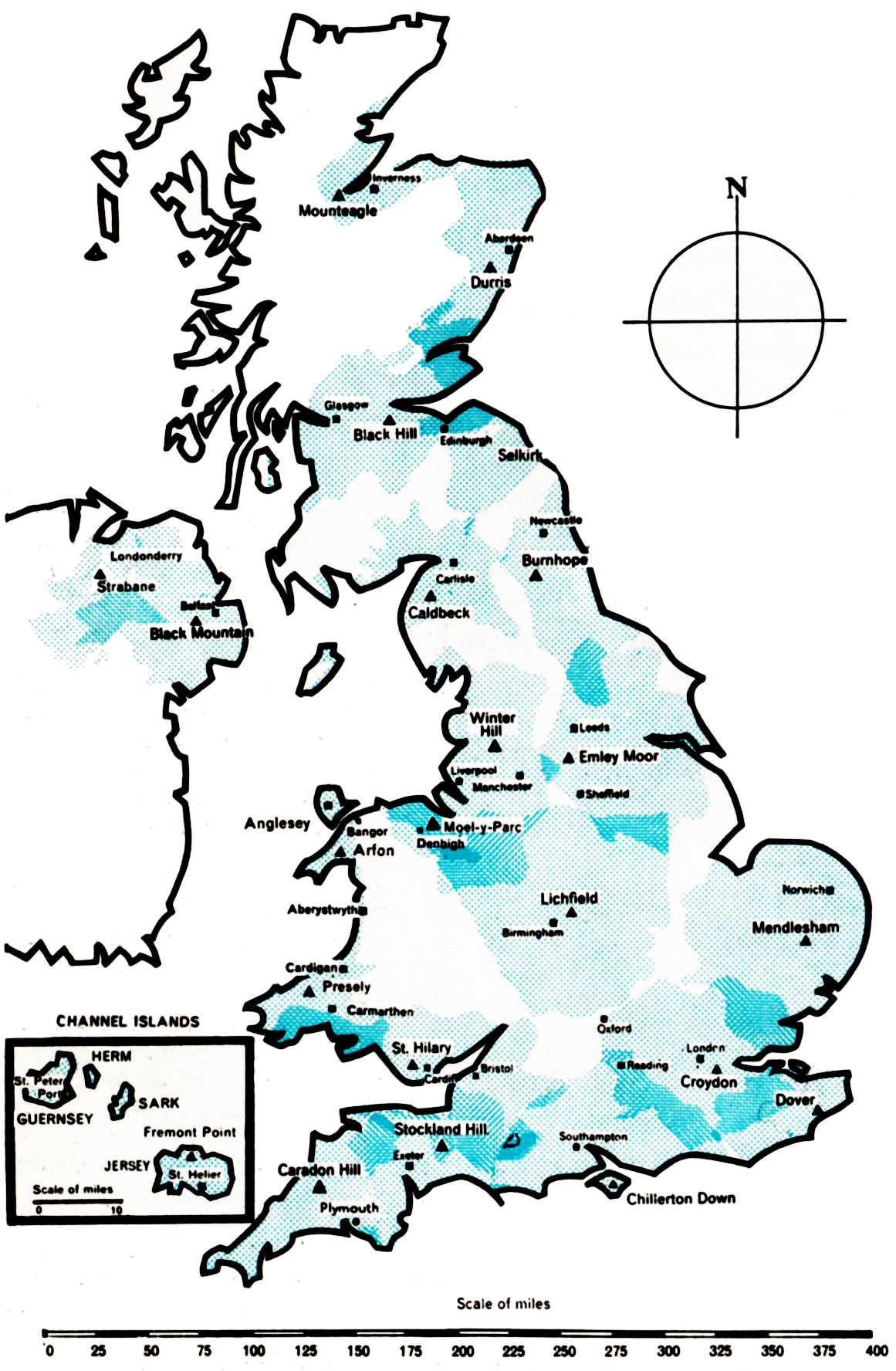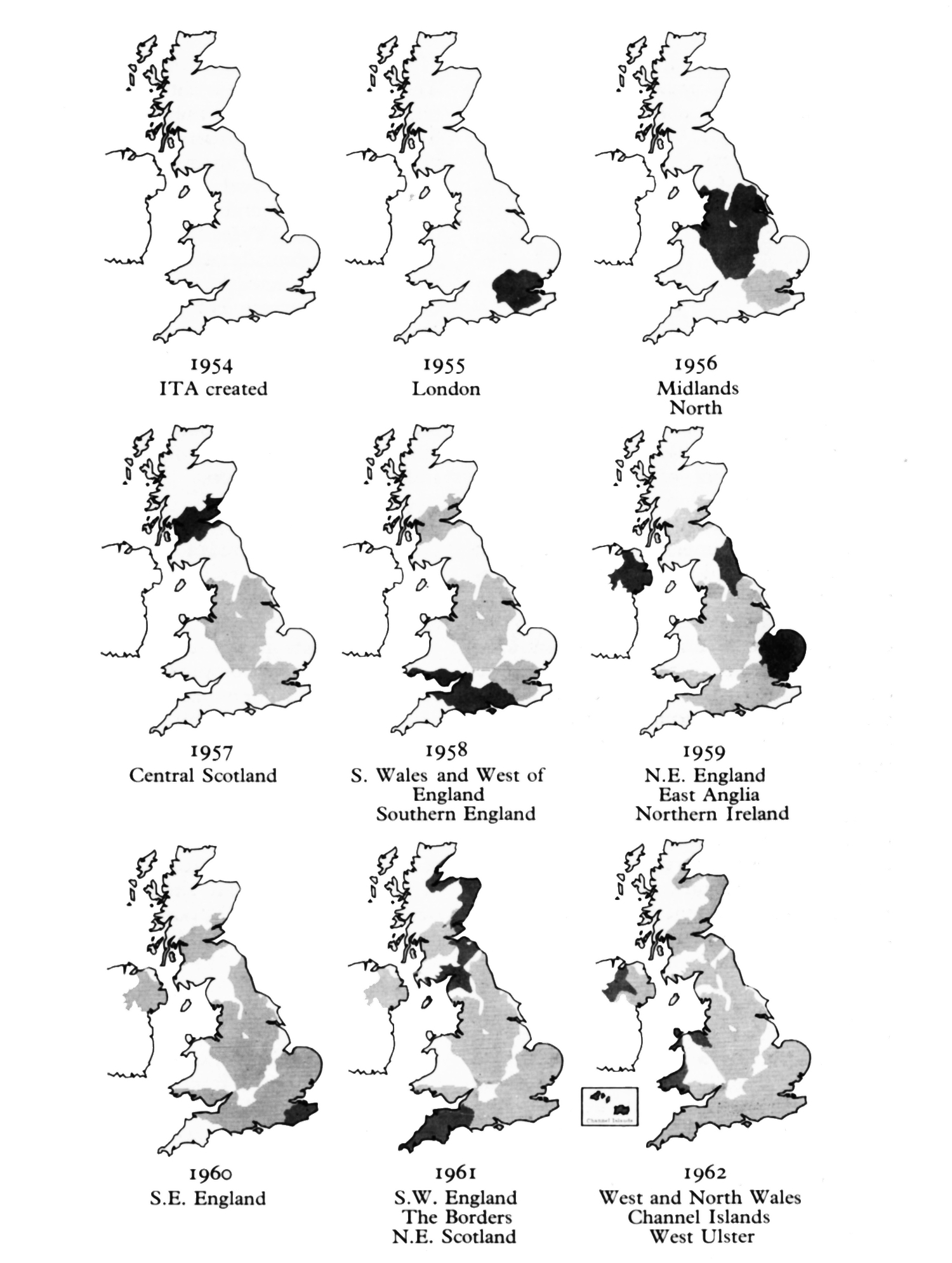Independent Television Authority
Sir John Carmichael, K.B.E., ACTING CHAIRMAN
Dame Anne Bryans, D.B.E.
Sir Sidney Caine, K.C.M.G.
Mr. A. C. Cropper, T.D., J.P., D.L.
Mr. J. Alban Davies, J.P.
Mrs Isabel Graham-Bryce
Sir Lucius O’Brien
Professor D. Talbot Rice, M.B.E.
Lord Williamson of Eccleston, C.B.E.
Professor Talbot Rice, Mr. Alban Davies and Sir Lucius O’Brien make the interests of Scotland, of Wales and Monmouthshire, and of Northern Ireland respectively their special care.

Headquarters: 70 Brompton Road, London S.W.3. Knightsbridge 7011
Scotland: 147 West Regent Street, Glasgow C.2. Glasgow City 3130
Wales and the West: Arlbee House, Greyfriars Place, Greyfriars Road, Cardiff. Cardiff 28759
Northern Ireland: 5 Donegal Square South, Belfast. Belfast 30818
The South: 30 Portland Street, Southampton. Southampton 29115
North-East: 32-4 Mosley Street, Newcastle-upom-Tyne. Newcastle 61-0148
East Anglia: Century Insurance Building, 24 Castle Meadow, Norwich. Norwich 23533
South-West: Royal London House, Armada Way, Plymouth. Plymouth 63031
The North: Astley House, Quay Street, Manchester 3. Manchester Blackfriars 2707
The Borders: 4 Victoria Place, Carlisle. Carlisle 25004 (9.30 a.m. to 12.30 p.m.)
The Independent Television Areas at the beginning of 1963 include 96 per cent of the population. The shaded areas are within the “fringe” contours of the Authority’s 22 transmitters (¼ Mv/m). There is, in addition, much satisfactory viewing in the white areas, and in fact it is only in the extreme north and north-west of Scotland and the mountainous centre of Wales that there is no effective provision. The darker shading shows the areas within reach of more than one ITA transmitter.
❦
The ITV System
The Independent Television Authority (ITA) was created in August 1954 to provide “for the period of ten years television broadcasting services, additional to those of the British Broadcasting Corporation . . . for so much of the United Kingdom, the Isle of Man and the Channel Islands as may from time to time be reasonably practicable”.
In accordance with the requirements of the Television Act 1954, the Authority builds, owns and operates the television transmitting stations. It selects and appoints the contractors to provide programmes for transmission from these stations. The contractors (more generally known as the programme companies) pay the Authority a rental related to the population coverage of the station or stations for which they provide programmes. They meet the cost of their ITA rentals, the cost of providing programmes and of their operations generally from advertising revenues. The Authority’s further duty is to ensure that the programmes provided are in accordance with the terms of the Act, and that the advertising transmitted is strictly controlled. Neither the Authority nor the companies draw any income from licence fees or other public funds.
The Nature of the System
The structure created by the Authority within the general framework laid down by the Television Act constitutes an entirely new combination of public and private initiative. In contrast to the unitary organisation with regional branches developed by the BBC, the Television Act requires the appointment of “a number of programme companies independent of each other both as to finance and control”. Moreover, Section 5(2) of the Act lays down that “It shall be the duty of the Authority to do all that they can to secure that there is adequate competition to supply programmes between a number of programme contractors independent of each other both as to finance and as to control”.
Only the existence of two directly competing companies in each service area could fully secure “adequate competition”. However, the frequencies which the Authority was granted were sufficient only to enable it to cover the whole country with a single network of stations. The Authority might have introduced direct competition in certain of its areas by building two stations, but only at the cost of leaving other areas without even one ITA service. The Authority therefore decided that while the limitations on its frequencies continued, it must use them to give national coverage by a single network.
Given one service only, the Authority had to choose the broad pattern of programme contracting which it would adopt. The fundamental choice was between a “unitary” system with a single programme company based in London providing programmes for the whole network of stations, and a plural system of separate programme companies for the individual areas of the country. There were sound social arguments for the appointment of separate companies to serve individual stations, and particularly for the communities outside London to be served by independently conducted programme companies rather than operated merely as satellites of a central group of London companies. The Authority, at the beginning of its life in 1954, therefore chose to adopt the plural form of organisation and has steadily pursued this policy ever since.
The adoption of a plural system did not of itself provide full competition to “supply programmes”, nor could it deny a programme company a local monopoly of viewers on the days for which it provided programmes. The Authority therefore sought from the beginning to introduce other competitive elements into the system. To avoid a London monopoly by one company there emerged the plan of enlarging the base from London to include, as well as the capital, the North and the Midlands and of appointing a total of four companies to serve this enlarged area. This was achieved by the division of the concession in each of the three areas into two parts, the weekdays and the weekends, and the creation of a mosaic of companies, stations, and days in a pattern which would support four independent companies.
The production of television programmes of national appeal demands large resources in the right places. It is no accident that networking – the supply of programmes for national use from some central source – is a common feature of broadcasting systems of all types in all the countries of the world. Effective television requires a high degree of specialisation in such programme categories as drama, light entertainment and variety, documentary programmes, sport, current affairs, children’s programmes, religious programmes and school programmes. And specialisation in any of these fields is practicable only when production is large enough to permit it. The distinctive features of Independent Television are not that it has a “network”, but that the supply of the main body of national programmes is provided by four separate companies, each of the four large enough to hold its own with the others, rather than originating from a single organisation; and that outside the most populous areas, programmes are provided by eleven smaller companies rather than by the extension of the geographical responsibilities of the four large companies and the creation of no further companies at all.
Fundamentally every one of the fifteen Independent Television companies is a regional company, the four largest no less than the remaining eleven; for each company is appointed to provide programmes for a particular area, and no company has any contractual rights or duties outside its own area. In each of the fourteen areas, the local programme company is responsible for providing all the programmes, whether these are produced by the company itself or acquired from other programme companies or other sources. Each local programme company as far as possible arranges its programmes into the pattern that best suits its region, subject always to conformity with the Authority’s directions in the matter of balance, quantity and quality.
The Coverage
The programmes provided by the programme companies are transmitted from the Authority’s stations. The system of 22 transmitters which now covers about 96 per cent of the population of the United Kingdom had to be developed by using a group of six channels in the frequency Band III, allocated to the Authority by the Postmaster-General. No direct experience of operating programme services in Band III in this country was available to guide the Authority’s engineers in the development of Band III, and they and the manufacturers had to start virtually from scratch. None-the-less, within three years, three-quarters of the population had been given access to Independent Television programmes. The extension of coverage is traced in the maps and tables which follow. The story of this engineering achievement is told more fully in the chapter “Technical Achievements”.
The Growth of Coverage
| End of year | Cumulative population coverage (thousands) | Percentage of total UK population % |
|---|---|---|
| 1955 | 12,290 | 24 |
| 1956 | 30,116 | 59 |
| 1957 | 33,666 | 66 |
| 1958 | 38,900 | 76 |
| 1959 | 44,366 | 86 |
| 1960 | 45,016 | 88 |
| 1961 | 48,587 | 94 |
| 1962 estd. | 50,981 | 96 |
THE SPREAD OF INDEPENDENT TELEVISION is progressively traced in these nine maps. The Television Act was passed in July 1954 and the Authority first met in August. The service began from Croydon on 22nd September 1955. The service areas shown in the final map include about 96 per cent of the population.
The Growth of I.T.A. Homes
| End of year | Cumulative ITA homes (thousands) | Percentage of all TV homes | Percentage of all homes |
|---|---|---|---|
| 1955 | 495 | 30.8 | 12.5 |
| 1956 | 2,656 | 53.3 | 25.8 |
| 1957 | 4,684 | 69.2 | 39.6 |
| 1958 | 6,540 | 75.9 | 46.6 |
| 1959 | 8,605 | 80.8 | 55.2 |
| 1960 | 10,292 | 87.0 | 65.4 |
| 1961 | 11,282 | 88.3 | 68.9 |
| 1962 estd. | 12,300 | 90.0 | 73.0 |
The Programme Companies and the News Company
Stringent conditions are required by the Act and have been applied by the Authority in the appointment of programme companies. The conditions are in the main designed to ensure that the programmes provided by the companies comply with the requirements of the Act and that the companies are capable of producing a balanced output of programmes of high quality; that control of the companies remains within the United Kingdom and does not change without the Authority’s prior approval; that the companies have no connection with persons or companies engaged in advertising; that they are and remain completely independent of each other both as to finance and as to control; and that due regard is had to the particular character of the areas which the regional companies serve.
The first four companies to be appointed, Associated-Rediffusion, ABC Television, Associated TeleVision and Granada TV Network, divide between them the task of providing programmes for the three largest areas of London, the Midlands and the North. Associated-Rediffusion serves the London area from Monday to Friday; Associated TeleVision the same area at weekends and the Midlands from Monday to Friday. Granada TV Network serves the North on weekdays and ABC Television the North and the Midlands at weekends. The other eleven companies have smaller population coverages and are responsible for the full week’s programmes in their areas, as follows: Central Scotland (Scottish Television), South Wales and West of England (TWW), the South and South-East England (Southern Television), North-East England (Tyne Tees TeleVision), East Anglia (Anglia Television), Northern Ireland (Ulster Television), South-West England (Westward Television), The Borders (Border Television), North-East Scotland (Grampian Television), Channel Islands (Channel Television), West and North Wales (Wales (West and North) Television).
 In order to provide an effective service of national and international news, the four original programme companies were encouraged by the Authority to join together to form a non-profit-making “common service” organisation. This organisation, Independent Television News (ITN), now provides the main news bulletins and certain other topical programmes for the whole of Independent Television.
In order to provide an effective service of national and international news, the four original programme companies were encouraged by the Authority to join together to form a non-profit-making “common service” organisation. This organisation, Independent Television News (ITN), now provides the main news bulletins and certain other topical programmes for the whole of Independent Television.
Programme Production
About 7,400 hours of television programmes were supplied by the Independent Television companies in 1961-1962 for transmission from the Authority’s stations. This represents nearly two-thirds of the total national television production of about 11,800 hours. The dominance of Independent Television in national television production is again reflected in the volume of local programmes. During the same period, Independent Television produced about four-fifths of all the programmes of local interest for local use -about 3,800 hours out of the national television broadcasting total of 4,800 hours. And while the BBC produced outside London about 33 per cent of its total output, Independent Television produced about 60 per cent. These Independent Television programmes came from thirteen independent companies, now increased to fifteen.
Because of their size, access to talent and general productive resources, the four companies in London, the Midlands and the North are the sources of many of the programmes which the other eleven companies use in addition to their own local programmes. However, the programmes produced by the other eleven companies, mainly programmes of local appeal, would be ample, in terms of the volume of production, to provide seven days of television a week without the use of any London, Midland or Northern programmes.
So it comes about that the average viewer of Independent Television programmes in Scotland, Wales, Northern Ireland and the smaller English regions sees programmes from at least five independent sources – from his own programme company, from Associated-Rediffusion, from Associated TeleVision, from Granada TV Network, and from ABC Television – as well as the national news bulletins and other programmes from Independent Television News. In much the greater part of the country in terms of population, he sees about as many hours produced by his local company as by any other single company.
The Procedure of the Authority
This system of interrelated companies, technical installations and control arrangements operates under the direct control of the Independent Television Authority. The Authority usually consists of a Chairman, Deputy Chairman, and eight Members. The Members of the Authority serve in a part-time capacity, though the Chairman is expected to make the work of the Authority his main interest. Three of the members have as their special care the interests of Scotland, Wales and Northern Ireland respectively. Members are appointed by the Postmaster-General “from among persons appearing to him to be qualified for the Office”, and the Minister is required to satisfy himself that they have no outside interests likely to affect prejudicially their conduct as members. Meetings of the Authority are held every three weeks, generally at its headquarters in London, but several times a year meetings are held in centres of Independent Television production in other parts of the United Kingdom. At the meetings the Authority’s policy is determined and all aspects of its work are reviewed.
The head of the Authority’s permanent staff is the Director-General, Sir Robert Fraser, O.B.E. The Authority employs a staff of about 550 people, of whom about 180 are headquarters administrative and technical staff, 350 technical staff manning the transmitters and 17 regional staff.
The main formal channel of communication between the Authority and the programme companies is a Standing Consultative Committee (SCC). Senior executives of each company and senior staff of the Authority attend the monthly meetings of ,this committee which sits under the chairmanship of the Authority’s Director-General. Between meetings a constant flow of information and consultation between the Authority’s officers and each company ensures that the Authority’s policy is understood and carried out. Through its Regional Officers the Authority is represented in the Regions. These officers are responsible for the day-to-day surveillance of the Independent Television output in their areas, as well as for liaison with local authorities, voluntary bodies and members of the public.
The Authority is advised by committees of experts in the field of Religion, Children’s and School programmes, Adult Education, and the control of advertisements.
Finance
Independent Television is financially self-supporting. No charge falls on public funds. Under Section 10 of the Television Act the Authority is charged
so to conduct its affairs as to secure that its revenues become at the earliest possible date, and thereafter continue, at least sufficient –
(a) to meet all sums properly chargeable to revenue account (including sums required for the repayment of loans and interest thereon, for provision for depreciation and/or the establishment and maintenance of their reserve fund); and
(b) to make provision towards, and as soon as practicable for necessary capital expenditure.
To enable the Authority to start operations, it was empowered under Section 12 of the Act to borrow from the Postmaster-General, with the consent of the Treasury, up to £2 million initial capital in its first five years. In fact, it proved necessary to borrow only £555,000, and this sum was wholly repaid by the middle of 1959. The Authority’s responsibilities under Section 10 are therefore fulfilled, both its revenue expenditure and its capital investment programme being paid for entirely out of the revenue from the programme companies.
Advertising
A full account of the provisions of the Act regarding the inclusion of advertisements in the programmes and of the Authority’s responsibilities in the advertising field is given in the chapter “Advertising Control”.
Two salient points are:
(i) Sponsorship is not allowed; advertisers are not allowed to supply, suggest or take credit for programmes. They may only buy time in the programmes in the same way as they would buy space in the press.
(ii) The frequency and permitted amount of advertising in the programmes are controlled by the Authority.
ITV’s Regional Pattern
London: The ITA’s transmitter at Croydon was opened on 22nd September 1955. It serves a population of 13 million in and around London. Programmes are provided by Associated-Rediffusion Ltd. (A-R) from Mondays to Fridays and by Associated TeleVision Ltd. (ATV) on Saturdays and Sundays.
The Midlands: The ITA’s transmitter at Lichfield was opened on 17th February 1956. It serves a population of 8¾ million. Programmes are provided by Associated TeleVision Ltd. (ATV) from Mondays to Fridays and by ABC Television Ltd. on Saturdays and Sundays.
The North: A population of 12½ million in Lancashire and Yorkshire is served by the ITA’s transmitters at Winter Hill and Emley Moor, opened in 1956. Programmes are provided by Granada TV Network Ltd. from Mondays to Fridays and by ABC Television Ltd. on Saturdays and Sundays. ITA Regional Officer: S. D. Murphy, Astley House, Quay Street, Manchester 3. Manchester Blackfriars 2707.
Scotland: THE ITA SCOTTISH COMMITTEE: Professor David Talbot Rice, M.B.E. (Chairman); Mr. Frank Donachy, O.B.E. 3 Mr. ]ohh Fergus, F.I.P.A.; The Rev. Arthur H. Gray; Dr. H. Stewart Mackintosh, C.B.E.; Sir William MacTaggart, P.R.S.A.; Mrs. T. N. Morgan; Miss Barbara L. Napier, J.P.; The Rev. Dr. W. A. Smellie.
Scotland is served by five of the ITA’s transmitters. A population of 4 million in Central Scotland is reached by the Black Hill station opened in 1957, the first after the three main areas had been covered. Programmes are provided by Scottish Television Ltd. (STV). North-East Scotland, with a population of 1.4 million, is served by the transmitters at Durris and Mounteagle, opened in 1961. Programmes are provided by Grampian Television Ltd. The southern borders of Scotland are served by the Caldbeck and Selkirk transmitters with programmes provided by Border Television Ltd. ITA Regional Officer for Scotland: John Lindsay, 147 West Regent Street, Glasgow C.2. Glasgow City 3130. (The Regional Officer for North-East England deals with the Border area.)
Wales and the West of England: THE ITA WELSH COMMITTEE: Mr. Jenkin Alban Davies, J.P. (Chairman); Dr. Ivor Davies; Miss Norah Isaac; Mrs. Enid Watkin ]ones; Mr. Thomas Ieuan Jeffrys Jones, M.A.; Major General Lewis Owain Pugh; Mr. Leslie Richards; The Rev. D. R. Thomas, M.A.
Two companies, TWW Ltd. and Wales (West & North) Ltd. (WWN), provide programmes for the Authority to broadcast to Welsh viewers. In addition to its responsibilities in South Wales, TWW also covers a wide area in the West of England; it provides programmes for the ITA’s transmitter at St. Hilary, opened in 1958, serving a population of 3.3 million. The technical difficulties of the area covered by Wales (West & North) Ltd. are indicated by the fact that three transmitters are needed in South-West, North-West and North-East Wales to broadcast its programmes to a population of about 1 million. These transmitters opened during 1962-63. ITA Regional Officer: L. J. Evans, Arlbee House, Greyfriars Place, Greyfriars Road, Cardiff. Cardiff 28759.
Southern England: Southern Television Ltd. provides programmes for Southern England from Kent to Dorset, an area which is not easily defined geographically or technically. The ITA’s transmitters at Chillerton Down on the Isle of Wight (opened in 1958) and at Dover (opened in 196O) serve a population of 4.3 million. ITA Regional Officer: Cmdr. G. W. Alcock, O.B.E., R.N. (Rtd.), 3o Portland Street, Southampton. Southampton 29115.
North-East England and Border Regions: The North-East of England, with programmes provided by Tyne Tees Television Ltd., is geographically, technically and socially well defined, consisting basically of the main part of the counties of Northumberland, Durham and the North Riding of Yorkshire. A population of 2.7 million is served from the ITAs transmitter at Burnhope, opened in 1959. Border Television Ltd. serves two nationalities as its area straddles the Anglo-Scottish border, its programmes being broadcast by one transmitter at Caldbeck and another at Selkirk in Scotland (opened 1961) to a population of nearly half a million. ITA Regional Officer: R. J. F. Larimer 32-4 Mosley Street, Newcastle-upon-Tyne. Newcastle 61-0148.
East Anglia: This was the first predominantly rural area in which the Independent Television Authority appointed a programme contractor, Anglia Television Ltd. This area is again both historically and geographically well defined. The topography of the area necessitated the first 1,000 ft. mast erected for the Authority, to serve a population of 2½ million. Programme operation commenced in 1959. ITA Regional Officer: Major General D. A. L. Wade, C.B., O.B.E., M.C., Century Insurance Building, 24 Castle Meadow, Norwich. Norwich 23533.
Northern Ireland: THE ITA ULSTER COMMITTEE: Sir Lucius O’Brien (Chairman); Mr. John G. Colhoun; Rev. Dr. C. B. Daly; Mr. G. B. Newe, O.B.E.; Mrs. G. Seth; Professor C. L. Wilson; The Rev. J. H. Withers.
The Province of Northern Ireland is served by two transmitters. The major one near the principal centre of population, the Belfast area, opened in 1959. The second, at Strabane in the west of the Province, opened early in 1963. Programmes are provided by Ulster Television Ltd. The population served is 1.4 million. ITA Regional Officer: W. H. Wilson, 5 Donegall Square South, Belfast. Belfast 3o818.
South-West England and the Channel Islands: Another geographically well-defined area is the South-West of England, consisting of the peninsula of Cornwall, Devon and parts of Somerset and Dorset. Westward Television Ltd. serves a population of 1.6 million from the ITA’s transmitters at Caradon Hill and Stockland Hill (opened in 1961). Programmes for the Channel Islands are provided by the smallest of all the fifteen ITV programme companies, Channel Television Ltd. Programme operation commenced during 1962. ITA Regional Officer: W. A. C. Collingwood, O.B.E., Royal London House, Armada Way, Plymouth. Plymouth 63031.
The Future
The whole of British broadcasting was brought under review between 1960 and 1962 by the Committee on Broadcasting (the Pilkington Committee) appointed by the Postmaster-General. The Report of this Committee, which appeared in June 1962, criticised certain features of Independent Television. Since the appearance of the Report, the Government has issued two White Papers on broadcasting policy, one in July and the other in December 1962. In the main, the policy outlined in these two White Papers does not contemplate implementation of the more radical reforms recommended by the Pilkington Committee. The Television Act 1954, which governs the content of Independent Television until 1964, will be amended by a Bill brought before Parliament in the early months of 1963 and expected to pass into law in the summer.
If Parliament accepts Government policy as outlined in the two White Papers, the broad outlines of Independent Television as it now operates and as it has been described above will remain, in the sense that the system will continue to consist of the ITA as the supervisory authority and a number of programme companies whose function it is to provide programmes for broadcasting by the Authority. The powers of the Authority in the programme field will, however, be clarified and strengthened, particularly in the matter of the exchange (or “networking”) of programmes among the different companies. There will also be significant changes in the policy which the Authority has to adopt over the rentals paid by the programme companies.
A detailed description of the differing responsibilities which will after 1964 fall upon the Authority and the programme companies will, however, not be possible until the amending Bill becomes law.
❦





